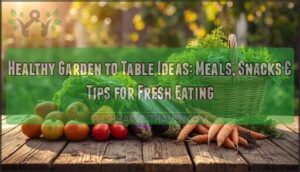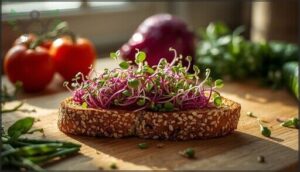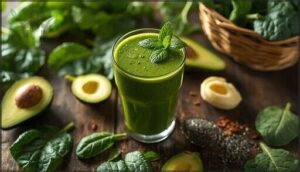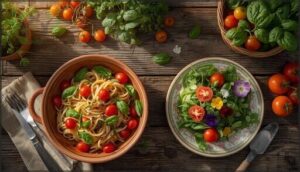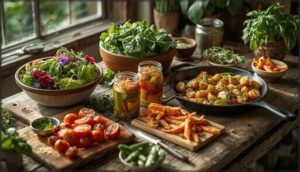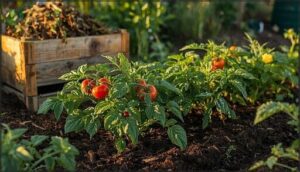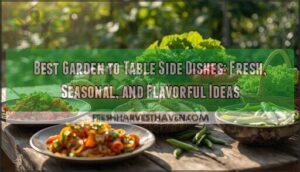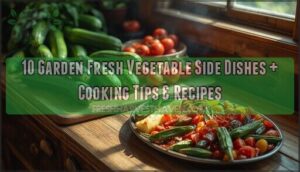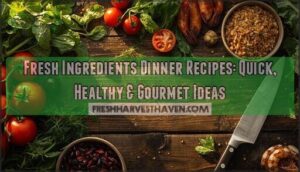This site is supported by our readers. We may earn a commission, at no cost to you, if you purchase through links.
That first bite of a sun-warmed tomato straight from the vine tastes nothing like the grocery store version. Your garden isn’t just a hobby—it’s a nutrition powerhouse that can transform every meal you make.
When you harvest vegetables at their peak and get them to your plate quickly, you’re locking in vitamins, minerals, and flavors that fade fast once produce leaves the soil.
The best part? You don’t need fancy recipes or culinary school skills to make the most of your harvest. Simple preparations let your fresh ingredients shine while delivering serious health benefits.
From protein-packed breakfasts to satisfying dinners and clever ways to preserve your bounty, you’ll discover how easy it is to eat well when your ingredients come from just steps away.
Table Of Contents
Key Takeaways
- Freshly picked garden vegetables deliver higher nutrient levels, better flavor, and more health benefits than store-bought produce.
- Simple garden-to-table recipes like omelets, salads, and stir-fries help you eat healthy meals quickly without fancy skills or ingredients.
- Planning meals around peak-season harvests reduces food waste, saves money, and keeps your menu exciting with vibrant, nutrient-rich dishes.
- Sustainable gardening habits—including organic practices, composting, and smart storage—keep your harvest eco-friendly and maximize freshness.
Easy Garden-to-Table Breakfast Ideas
Starting your morning with fresh produce from your garden sets a nutritious tone for the whole day. You don’t need fancy recipes or complicated techniques to turn your harvest into a satisfying breakfast.
Here are four simple ways to transform your garden greens and vegetables into energizing morning meals.
Garden Omelets With Seasonal Greens
When you fold fresh garden greens into eggs, you’re getting a powerhouse breakfast that delivers 14 grams of protein and about 40% of your daily vitamin K in just 10–15 minutes. Seasonal varieties like spring spinach or winter kale boost flavor while supporting heart health and glycemic control.
A great way to start the day is with a garden vegetable omelet. Garden-to-table sourcing means maximum nutrient density, turning simple vegetable recipes into sustainable, healthy eating wins.
Kale and Veggie Frittatas
Kale frittatas are a great step up in nutrient density! You’ll pack in about 10 grams of protein per slice, plus 4–6 grams of fiber from colorful bell peppers, broccoli, and onions.
This garden-to-table combo promotes satiety and delivers 735% of your daily vitamin K from kale alone. As a flexible dish, frittatas can be served for brunch or dinner.
Cook to 160–165°F for food safety, then enjoy a veggie-packed, healthy eating win!
Sprout Toast With Microgreens
Microgreens on sprouted-grain toast deliver 2–3.5 times the nutrient density of mature greens—think 6-fold more vitamin C in red cabbage sprouts! Sprouting benefits include lower blood sugar spikes and better mineral absorption.
Despite market trends showing 28% growth, safety concerns remain: vulnerable groups should avoid raw sprouts.
For fresh produce from your garden to table, rinse microgreens well and refrigerate below 40°F for healthy eating.
Fresh Green Smoothies
Blend spinach or kale from your garden into a morning smoothie to preserve fiber while delivering about 60 mg of nitrates—enough to lower blood pressure by 2.5 mm Hg! Balance fresh produce with low-sugar bases to avoid 6+ teaspoons of free sugars per cup.
Watch oxalate risks if you have kidney concerns, and pair leafy greens with healthy fats for nutrition and wellness that promotes healthy eating every day.
Quick Garden-Fresh Lunch and Dinner Recipes
When lunch or dinner rolls around, your garden can deliver meals that are both quick to prepare and packed with flavor.
These recipes take 30 minutes or less and highlight what’s growing right outside your door.
From vibrant summer salads to cozy pasta dishes, you’ll find simple ways to turn your harvest into satisfying main courses.
Grilled Summer Vegetable Salads
A big bowl of grilled summer vegetables is like sunshine on your plate! Grilling preserves more vitamins than boiling while bringing out natural sweetness. When you pair grilled veggies with olive oil dressing, you boost absorption of important nutrients that promotes heart health.
- Mix 4–6 different vegetables like zucchini, peppers, and eggplant for maximum nutritional variety
- Keep grilling temperatures moderate and avoid charring to minimize potentially harmful compounds
- Add 3–4 servings of grilled vegetables to create a satisfying meal that aids healthy weight management
Stuffed Peppers and Tomatoes
Stuffed bell peppers and tomatoes turn your garden’s fresh produce into nutrient-packed meals that deliver big flavor! Traditional beef-and-rice versions provide 21.5 grams of protein and 6.1 grams of fiber per serving. For lighter prep techniques, try plant-based filling variations with quinoa and lentils—you’ll cut saturated fat while keeping it delicious.
| Nutrient | Per Serving |
|---|---|
| Protein | 19–21.5g |
| Fiber | 6.1g |
| Vitamin C | 25mg (28% DV) |
| Potassium | 439mg |
Recipe customization means using what’s ripest in your garden-to-table approach! Tomato salad and vegetable recipes benefit from garden freshness—homegrown produce contains 20% more vitamins than store-bought. Nutritional benefits multiply when you control sodium and get the most out of seasonal ingredients!
Zucchini and Squash Stir-Fries
Garden-fresh zucchini and summer squash stir-fry bring exceptional flavor and nutrient retention when you cook them quickly! A 150-gram serving delivers about 80 calories, 3 grams of fiber, and 73 mg of vitamin C. These vegetable recipes shine with garden-to-table freshness!
- Keep cooking time under 10 minutes to preserve vitamin C
- Use minimal oil (about 1 tablespoon) for heart-healthy fat content
- Skip high-sodium sauces—try herbs instead to control sodium content
- Mix in colorful peppers for extra antioxidants
- Stir-fry at high heat to maintain crisp texture and heighten dietary impact
Asparagus and Lemon Pasta
Your spring asparagus shines in this vibrant pasta dish—it delivers 307-442 calories and 20-25 grams of protein per serving! This garden-to-table recipe captures peak seasonal nutrition when asparagus is harvested fresh.
Try recipe variations with whole-wheat pasta for extra fiber, or add peas for more color. Simple cooking techniques like quick sautéing preserve vitamin C, while lemon juice boosts iron absorption from these sustainable ingredients!
Seasonal Sides and Snacks From Your Garden
Your garden doesn’t just deliver main courses—it’s a goldmine for sides and snacks that bring color and nutrition to every meal. From crisp spring salads to hearty roasted veggies, these dishes make it easy to enjoy what’s in season.
Here are four garden-fresh options that’ll keep your table interesting all year long.
Pea and Lettuce Spring Salads
When fresh peas and tender lettuce are at their peak from May through July, you’ve got the perfect ingredients for a nutrient-packed spring salad!
These garden to table creations deliver about 77% of your daily vitamin A and 45% of vitamin C per serving.
Try pairing blanched peas with butter lettuce, fresh herbs like mint or dill, and a simple lemon vinaigrette for a seasonal side that’s ready in just 15 minutes.
Roasted Root Vegetable Medleys
Roasted carrots, beets, and parsnips bring earthy sweetness to your garden-to-table rotation! One cup delivers 7 grams of dietary fiber and 580 mg of potassium.
For maximum nutrient retention, roast at moderate heat with a touch of oil—this boosts beta carotene absorption while keeping acrylamide formation low.
Sustainable production and smart roasting methods make these seasonal recipes a win for healthy eating habits!
Kale Crunch and Cabbage Slaws
Crunchy kale and cabbage slaws pack serious nutritional firepower for your garden-to-table meals! These seasonal recipes deliver 46% of your daily vitamin C per serving and support cardiovascular outcomes through improved gut microbiota. The fiber benefits from these cruciferous vegetables help you feel full longer while reducing disease risk.
Try these fresh produce ideas:
- Shredded kale with apple cider vinaigrette
- Red and green cabbage mix with lemon
- Rainbow slaw featuring garden carrots and peppers
Homemade Herb Dips and Salsas
Your herb garden truly shines when you transform fresh herbs into vibrant dips and salsas! Fresh garden salsa prepared with seasonal produce stays fresh for 3–4 days refrigerated, while cooking with fresh produce greatly reduces sodium compared to store-bought versions.
Try reduced-sodium recipes featuring dill, basil, and chives paired with garden vegetables. Smart vegetable pairings and safe storage boost your fresh herb selection’s flavor combinations!
Healthy Meal Planning With Garden Harvests
Planning meals around your garden harvest doesn’t have to be complicated. With a few smart strategies, you can make the most of every vegetable and herb you grow while keeping meals exciting and nutritious.
Here’s how to turn your garden bounty into a week’s worth of delicious, waste-free eating.
Building Menus Around Peak Produce
When you plan around peak produce, you’re setting yourself up for meals that taste better and cost less. Seasonal availability means your garden ingredients are at their nutrient density peak, which translates to healthier plates. Local sourcing from your backyard also keeps menu costs down while matching customer preferences for fresh, flavorful food.
- Spring asparagus delivers maximum vitamins when harvested at just the right moment
- Summer tomatoes burst with antioxidants you simply can’t get from winter imports
- Fall squash offers budget-friendly nutrition that makes seasonal meal planning a breeze
- Garden herbs transform simple dishes into restaurant-quality fresh produce recipes
Reducing Food Waste With Creative Recipes
Your garden’s surplus is a gift, not garbage. Flexible recipe development cuts household food waste by up to 46%. Transform broccoli stems into creamy hummus or bake potato peels into crispy chips—scrap repurposing makes every bit count!
| Garden Scrap | Upcycled Recipe Idea |
|---|---|
| Vegetable peels | Homemade vegetable stock |
| Herb stems | Flavorful pesto base |
| Tomato cores | Garden salsa starter |
| Kale ribs | Sautéed greens side |
Donation campaigns and community fridges help share your harvest while reducing waste.
Batch Cooking and Freezing Garden Veggies
Freezing your harvest locks in nutrition and saves time on busy weeknights! Blanching techniques—like steam blanching broccoli for about 5 minutes—help with nutrient retention while keeping colors bright.
Cool veggies fast, then use proper packaging methods to prevent freezer burn. Freezer storage at 0°F keeps your produce tasty for 8–12 months.
These food preservation methods make home gardening tips work harder for you!
Using Herbs for Flavorful, Low-Sodium Meals
With fresh herbs from your herb garden, you can slash sodium by nearly 1,000 mg daily while boosting flavor enhancement! Studies show using herbs instead of salt helps with recipe compliance and sodium reduction without sacrificing taste.
Fresh herb recipes deliver herb benefits that make healthy meal ideas exciting. Consumer trends confirm this garden-to-table approach works—people enjoy meals more when fresh herbs lead the way!
Sustainable and Organic Gardening Tips
Growing your own food isn’t just about what ends up on your plate—it’s also about how you grow it. The methods you choose can make your garden healthier for you and kinder to the planet.
Let’s look at some simple ways to garden sustainably and get the most out of every harvest.
Growing Vegetables in Small Spaces
You don’t need sprawling land to grow your own food! A 10×10 foot plot can yield 100–150 pounds of produce per season—enough to supplement your meals for months.
Try vertical gardening with trellises or container selection using 5-gallon buckets for tomatoes and leafy greens.
These home gardening tips make organic gardening for beginners achievable, even on balconies, while supporting soil health and simple pest control.
Organic Practices for Healthier Produce
Switching to organic gardening cuts your dietary pesticide exposure dramatically—one study found a 98.6% drop in just two weeks! Organic practices boost nutrient density, with higher antioxidant levels in your homegrown veggies.
Organic gardening slashes pesticide exposure by nearly 99% in just two weeks while boosting nutrient density in your homegrown vegetables
You’ll also improve soil health and support sustainable food systems. These ecosystem impacts ripple outward, protecting local wildlife while your garden-to-table cooking delivers real human health benefits with every delicious bite.
Composting and Reducing Food Waste
Your garden scraps aren’t trash—they’re tomorrow’s nutrient-rich soil! Composting slashes methane reduction by keeping organic waste from landfills, where it would otherwise generate harmful gases. Plus, households save roughly $700 per ton in waste diversion costs.
Here’s how composting strengthens sustainable food systems:
- Sequesters carbon dioxide equivalents
- Delivers economic incentives through reduced hauling fees
- Creates program innovation in community initiatives
- Fosters ecofriendly living practices
- Enhances organic gardening tips with richer soil
You’ll transform kitchen waste into food preservation methods that feed your garden naturally!
Harvesting and Storing for Maximum Freshness
Timing your harvest when vegetables hit peak ripeness—think vibrant color and firm texture—cuts spoilage by up to 30%! Early morning picking keeps produce crisp and nutrient-dense.
Proper storage conditions and gentle handling transform your garden-fresh produce into food preservation methods that honor sustainable food systems!
| Storage Element | Ideal Conditions | Shelf Life Extension |
|---|---|---|
| Temperature | 32–40°F with 90–95% humidity | 1–6 months (varies by crop) |
| Packaging methods | Modified atmosphere, absorbent pads | Several days to weeks |
| Nutrient retention | Cool, dark storage minimizes losses | Preserves 60%+ vitamins |
| Spoilage delay | High humidity for leafy greens | Up to 7+ days refrigerated |
Frequently Asked Questions (FAQs)
What are the best vegetables for beginner gardeners?
Start with leafy greens like spinach and lettuce—they’re the fastest growing vegetables with high yields in tiny spaces!
Cherry tomatoes, bush beans, and radishes are also kid-friendly winners for container gardening success.
How do you naturally control pests without chemicals?
You can protect your organic and sustainable food with several eco-friendly methods. These include introducing beneficial insects like ladybugs, companion planting with marigolds, and using physical barriers such as row covers.
Additionally, organic pesticides like Bt and habitat management are effective strategies for maintaining an eco-friendly living environment.
Can you grow food year-round indoors?
You can harvest lettuce, spinach, cherry tomatoes, and herbs indoors all year using hydroponic systems or sunny windowsills. LED lighting and compact varieties make sustainable living and garden-to-table cooking possible in any season.
What nutrients do homegrown vegetables provide most?
Garden fresh vegetables deliver impressive vitamin density—especially vitamins A, C, and K—plus solid mineral content like potassium and iron.
Their antioxidant levels and fiber benefits shine brightest right after harvest, making freshness impact huge!
How does gardening improve mental health and wellness?
Ever wonder why pulling weeds feels surprisingly calming? Gardening reduces stress and anxiety while boosting cognitive function through hands-on tasks.
It builds social connection, increases physical activity, and creates a meaningful sense of purpose for lasting wellness.
Conclusion
From garden gate to dinner plate, you’ve got everything you need to nourish yourself and the people you care about. These healthy garden-to-table ideas prove that eating well doesn’t require complicated techniques or expensive ingredients.
Your freshly harvested vegetables already contain the flavors and nutrients that make every meal special. Start small, experiment with what grows best in your space, and watch how simple cooking transforms into something truly meaningful.
- https://odh.ohio.gov/media-center/feature-stories/march-is-national-nutrition-month
- https://pmc.ncbi.nlm.nih.gov/articles/PMC10260856/
- https://www.ecofriendlyhomestead.com/sustainable-garden/learn/nutrient-dense-foods-grow-your-own
- https://www.gardentech.com/blog/gardening-and-healthy-living/garden-to-table-goodness-and-nutrition
- https://extension.unh.edu/blog/2022/05/health-benefits-eating-locally

